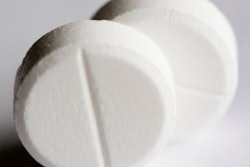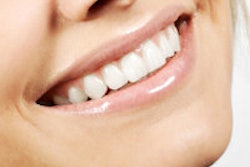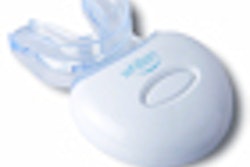
Use of light activation increases the risk of tooth sensitivity during in-office bleaching and also may not improve the bleaching effect, according to a new systematic review and meta-analysis (Journal of Dentistry, August 2012, Vol. 40:8, pp. 644-653).
With the rising popularity of teeth whitening, new systems have been developed that use light -- including halogen, curing lights, xenon-halogen lights, plasma arcs, light-emitting diodes (LEDs), lasers, and LED plus lasers -- to speed up the whitening process while generating less heat, according to the study authors, from Sichuan University and Sichuan Center for Disease Control and Prevention in China.
While many manufacturers have claimed that light-activated bleaching systems can lighten tooth color by eight shades or more in just one visit and the media also has highlighted its benefits, the scientific literature remains divided, they noted.
And while some studies have shown positive effects of light activation, others have demonstrated little to no contribution to outcomes, and all the while there has been increasing focus on tooth sensitivity during light-activated bleaching.
While several reviews of light-activated bleaching are available in the literature, no one has conducted quantitative assessments of the original studies, and the volume of information makes it difficult to draw conclusions, according to the study authors.
The researchers conducted a literature search using Medline, Embase, and Cochrane Central up to September 2011 and considered all randomized controlled trials (RCTs) or quasi-RCTs comparing light-activated bleaching systems with nonactivation bleaching systems.
The meta-analysis ultimately included 11 studies: nine RCTs and two controlled clinical trials. All 11 compared bleaching efficacy, and seven compared tooth sensitivity.
The studies involved subjects age 18 years or older. Only in-office bleaching systems were included, and the light activation method could involve any kind of light.
The researchers found that a light-activated system produced better immediate bleaching effects than a nonlight system when lower concentrations of hydrogen peroxide (15% to 20% HP) were used. However, when high concentrations of HP (25% to 35%) were employed, they found no difference in the immediate or short-term bleaching effect between the light-activated system and the nonlight system.
The meta-analysis also demonstrated a significantly higher likelihood of tooth sensitivity with the light-activated system than with the nonlight system.
"Tooth sensitivity is the most frequently reported side effect after vital tooth bleaching," the authors wrote. "Our pooled analysis suggests that a light-activated system is likely to increase the occurrence or severity of tooth sensitivity."
Because light increases the risk of sensitivity during in-office bleaching, clinicians may need to reconsider the rational application of bleaching lamps, the authors noted. Also, when light activated bleaching procedures are conducted, dentists should follow the manufacturer's instructions to limit the duration of light activation, especially to minimize undesired pulpal responses.
"Light increases the risk of tooth sensitivity during in-office bleaching, and light may not improve the bleaching effect when high concentrations of HP (25% to 35%) are employed," the authors concluded. "Therefore, dentists should use the light-activated system with great caution or avoid its use altogether."
A recent clinical study that looked at both bleaching effectiveness and sensitivity reached a similar conclusion (Operative Dentistry, May/June 2011, Vol. 36:3, pp. 251-257).
The study evaluated the effects of LED and laser activation during in-office bleaching where 30 caries-free patients were divided into two groups: light-activated and nonactivated groups.
"After two bleaching sessions, the use of LED/laser light activation did not improve bleaching speed," the study authors wrote. "Persistent tooth sensitivity and higher tooth sensitivity after 24 hours of bleaching were observed when light activation was used."



















